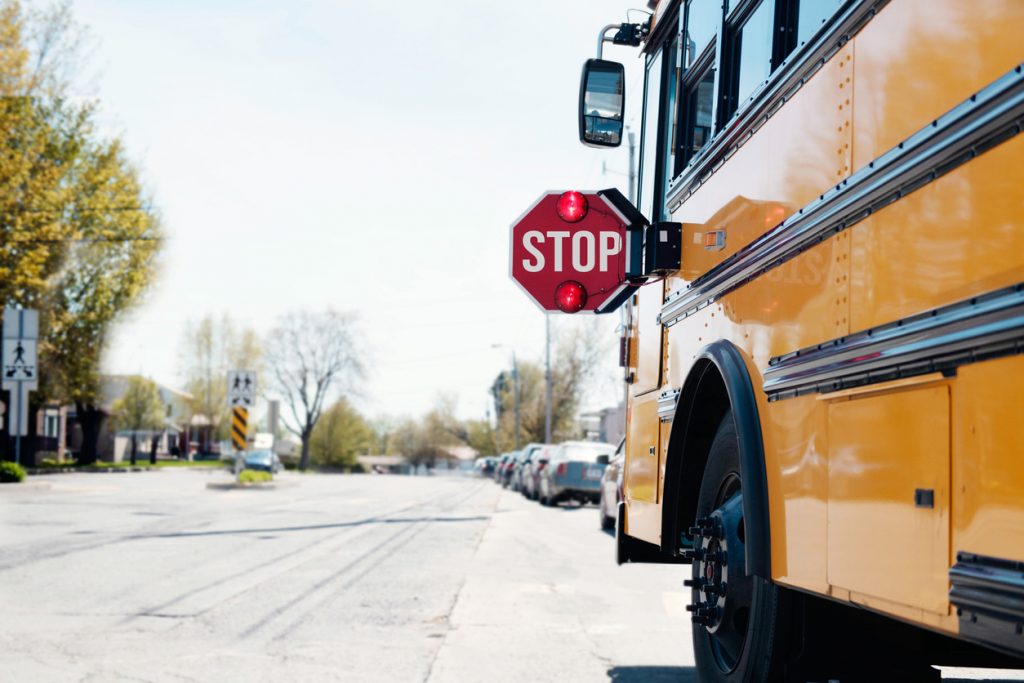Why Don’t School Buses Have Seat Belts?

I remember securing my newborn child into her car seat for the first time, fastening her in and double-checking every strap before leaving the hospital. It was a little bucket seat that clicked into a base, keeping my baby locked and loaded as we travelled along city roads. I had chosen the seat carefully, looking for something with a great consumer rating at a reasonable price point. As she grew, I’d swap out that bucket seat for a larger infant seat, a toddler seat and eventually, a high-back booster. She’s nearly nine years old now but at only 48 lbs, she still sits in a booster just like her younger brother. Safety first, right?
When that newborn baby was in junior kindergarten, she went on her first field trip. I remember being a bit nervous about her leaving the school, feeling extra relief as I picked her up that day. “She was very cute on the bus,” her teacher told me, clearly amused. “She insisted on sitting in the front row, where the accessible seats are because it’s the only part of the bus that has seat belts.”
Wait, what? I heard a record scratch in my brain as I paused to process this information. I knew that school buses don’t typically have seat belts, of course, but it’s not something I’d put a lot of thought into until that moment. My child and her classmates, who were normally strapped into strictly regulated safety devices while travelling by car, were hurtling along the highway in a vehicle with no seat belts.
And that was ok, apparently?
It’s a weird thing to get your head around. I still cut my kids’ grapes in half when I pack a school lunch, but I’ve sent them on field trips in a bus with no seat belts. Other kids take a bus every day, travelling to and from school with nary a belt in sight. It’s legal, clearly, but gives me a flutter of concern that I can’t quite push down. So why are school buses designed this way, and are they truly safe for our children? The answer to the latter, unfortunately, is “maybe”.
Historically, Transport Canada has said that school buses didn’t need seat belts
The department’s website previously said there was “no evidence that three-point seat belts would improve the overall level of safety on a school bus,” citing a compartmentalization design that features strong seat anchorages and high, padded benches that are placed closely together. Additionally, school buses are built using shatterproof glass windows, reinforced sides and raised floors, in addition to exterior safety features such as their bright yellow colour and light-up stop signs. The ministry’s argument was that kids of all ages ride on school buses, and seat belts might actually add risk if not adjusted to the appropriate fit. Currently, the Independent School Bus Operators Association is sticking with this statement, with their website noting, “Studies have shown that adding seat belts to the current seating configuration of a school bus can increase the chance of head and neck injuries.”
So, adding seat belts would be MORE dangerous, then?
Well, not necessarily. Those statements were made based on a 1984 study that has been repeatedly contradicted by subsequent research, particularly when side impact or rollover collisions were the focus. In fact, a number of independent studies have been conducted over the past ten years, including a Fifth Estate investigation that concluded, “Thousands of injuries and numerous child deaths could have been prevented across Canada and the United States in the past three decades had school buses been equipped with seatbelts.”
If that sounds pretty damning, it is.
After additional research – some performed after serious collisions involving school buses in Canada – Transport Canada’s website was updated and now acknowledges, “Seat belts have a proven safety record. Transport Canada mandates them on a variety of vehicles, including passenger cars. When they are used and installed properly, seat belts on school buses can offer another layer of safety to complement the existing, highly effective protection provided by compartmentalization.” It goes on to repeat that seat belts must be used properly to effectively increase passenger safety (which can mean adjusting the belt to fit various children). At this time, some school bus operators have had seat belts installed, but the majority have not.
What does this mean for our kids’ safety? In short: school buses are relatively safe, but they could be much safer. Seat belts on school buses, when used properly, are proven to reduce the risk of injury or death. However, using seat belts properly adds time and energy that school bus operators simply may not have. While Canada’s transport minister has announced a task force on potentially outfitting all school buses with seat belts, the law does not currently require it. A different law recently passed, ruling that all medium and large size highway buses built after September 2020 must have seat belts installed. However, this law does not apply to school buses or existing vehicles.
For parents, that leaves a lot of unanswered questions and room for concern.
Parents aren’t the only people questioning the safety of school bus travel. A number of school bus operators have joined the push for mandatory seat belts, with several calling the lack of belts a “money issue” rather than a decision based on actual safety. Basically, adding seat belts to thousands of buses would be very expensive – plus, it might reduce the passenger capacity per bus, requiring more vehicles per region. Admittedly, none of that sounds cheap or easy – but we’re talking about the well-being of children. It’s been proven time and time again that when used properly, seat belts save lives. Knowing this, is Transport Canada deciding NOT to make seat belts mandatory really about safety at all? It’s a question worth asking yourself, and perhaps raising with our elected officials.
Sending our kids out into the world can be scary, and we can’t swathe them in bubble wrap or eliminate any sign of danger from their lives. What we can do is advocate for measures that limit their risk of injury or worse, and that includes personal and school-related transportation.
If you’d like to contribute to this discussion, please consider reaching out to your school board, your local representatives or the department of the Minister of Transport.
When we know better, we do better, and it’s high time we made these improvements for the sake of our kids.












